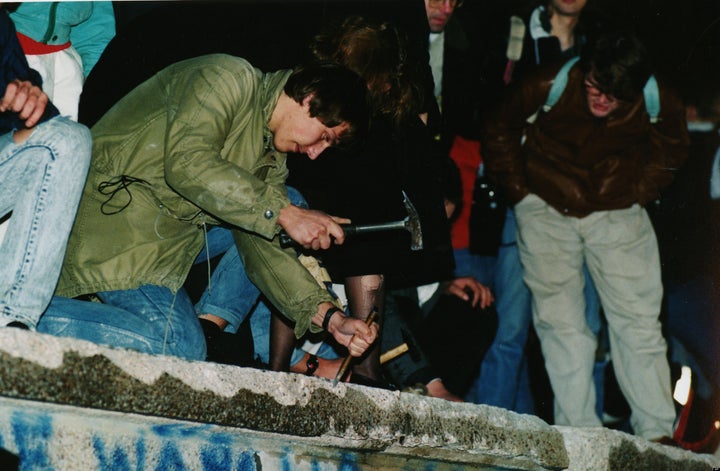
One crisp autumn morning after a long night of Wildbrau beer and Spaetzle noodles, I awoke atop an Ikea bunk bed to find David Hasselhoff hovering over me, wearing nothing but his "Baywatch" bikini. I was disoriented. He was tan and hairy, with a smile the size of Stuttgart. When I leaned in to have a closer look, we bumped noses. Lucky for me, he was just a magazine pinup taped to the ceiling. (Darn the low clearance in these Hanseatic-era houses!) I heard a muffled giggle from the bunk below, then I remembered where I was: spending the weekend in Hamburg with a friend's family and her five younger siblings.
The Hasselhoff-on-the-ceiling prank was but one in a long line of pop-cultural awakenings I experienced in the fall of 1989 during my semester abroad in the land of eternal Oktoberfest. In those days, a still-divided Germany lay at the crux of tradition and tackiness. Sure, the West had the historic part down pat: Albrecht Durer's self-portrait in Munich's Alte Pinakothek and the Cologne Cathedral were proof plenty of that. Yet even if the East (where government-run TV and radio were stuck in the 1950s) was much worse off, the idea of "Knight Rider" as West Germany's top-selling singer and posterboy was hard to swallow.
On a certain level, it made sense. As revolutions multiplied across Eastern Europe -- and the globe -- the West German pop charts offered respite from the turmoil in the form of kooky confectionery such as "Swing the Mood" by Jive Bunny and the Mastermixers or Kaoma's "Lambada." There was good stuff, too: inside the big-box retailer World of Music (WOM), I broke-in my new emergency-only American Express card with the Gipsy Kings' Mosaique, Paul McCartney's Flowers in the Dirt, Lisa Stansfield's Affection, and -- one of my favorite albums of all time -- Tears For Fears' The Seeds of Love. The latter, with its sweeping orchestrations and politely defiant lyrics, captured both the bombast of 1980s and the fragility of what Time magazine labeled "1989: The Year that Changed the World."
A little more than halfway through my semester in Germany, it was time for our group to visit The Wall. Armed only with our Sony Walkman cassette players, passports, and naivete, my classmates and I boarded a bus one frigid November night to make the trek from Munich to Berlin. The trip had been planned for months, yet none of us could have predicted that the East German government would collapse before we got there, or that we'd have our very own chance to chip away at history. We were just 19-year-old Yanks who'd been fed a steady diet of Rocky IV Cold War hype for years. So, who knew if some crazy version of Ivan Drago was waiting in the wings to push the big red nuke button the moment the first chisel hit the Wall?
We were, admittedly, a bit afraid. On that overnight ride, as we crossed borders and snowflakes lit the way, I took shelter behind my headphones and the soothing synths and lilting flugelhorn in Tears For Fears' end-of-the-world ballad, "Famous Last Words":
Hand in hand we'll do and die
Listening to the band that made us cry
We'll have nothing to lose
We'll have nothing to gain
Just to stay in this real life situation
For one last refrain
When we finally got to the Berlin Wall, we were relieved to witness a glorious, curious dichotomy. There were guards with machine guns and scary-looking military uniforms. There were street vendors selling everything from bootlegged Michael Jackson videos to sugar-coated almonds. On one side of the Brandenburg Gate, life had all the vibrancy and momentum of Keith Haring's famous dancing-figure murals; on the other, even the weather seemed consumed by a gray pall. Yet for all the beauty on both sides of Berlin's crumbling concrete divider, the artsy city that would later become the birthplace of U2's 1991 rock masterpiece Achtung Baby couldn't deny that, on this November day in 1989, its star was not the Wall, but rather the smorgasbord of sounds streaming through it.
We watched for hours as East Germans flowed into the West, lined up at banks for their "Begrussungsgeld" (welcome money), and left stores with bag after bag of electronics. It was liberation by boombox: Big-band swing. Brazilian samba. Bad ballads. As twilight fell, thousands queued up to go back to their homes in the East, satisfied that the battery-operated gadgets they now hoisted above their heads, John Cusack-style, would get them one step closer to the coveted Western lives they'd been missing.
We took photos. We hammered out our own pieces of the Wall. We celebrated with folks from East and West. At the end of the day, we were but tourists in the whole charade. Yet one American fit right in: David Hasselhoff. His "Looking for Freedom" may have been an unlikely anthem for such an auspicious moment in history, but I'll never forget its catchy refrain blaring proudly from every radio as we watched so many reunited Germans shoulder up their country's #1 song.
